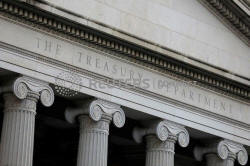U.S. Treasury yields 2020 drop makes way for slow grind back in 2021
 Send a link to a friend
Send a link to a friend
 [December 31, 2020] By
Saqib Iqbal Ahmed and Ira Iosebashvili [December 31, 2020] By
Saqib Iqbal Ahmed and Ira Iosebashvili
NEW YORK (Reuters) - The U.S. Treasuries
market took investors on a bumpy ride in 2020, with yields plunging to
historic lows in the early part of the year before a partial grind back
in the second half.
Investors are looking for yields to edge up further as the calendar
flips to 2021.
Expectations that a vaccine against COVID-19 will spur an economic
rebound in 2021 have pushed some investors out of Treasuries and other
safe-haven assets in recent months and helped lift yields, which move
inversely to bond prices, near their post-pandemic highs just under 1%.
Still, they are well off the levels seen at the beginning of the year,
when benchmark 10-year Treasuries yielded closer to 2%.

Graphic: Crawling back
https://fingfx.thomsonreuters.com/
gfx/mkt/xlbvgmgoavq/
Pasted%20image%201607524008468.png
The post-pandemic drop in Treasury yields, spurred by unprecedented U.S.
Federal Reserve support, had wide-ranging repercussions, forcing
investors to rethink the role of bonds as a hedge against stock
gyrations and spurring a scramble for yield across markets. Prices for
gold, which often struggles to compete with yield-bearing investments,
are up about 24% year-to-date, its best year in a decade.
"The renewed hunt for yield means investors need to take a look at the
role of... bonds in portfolios," analysts at UBS wrote in a report.
Few investors believe Treasury yields are going back to their
pre-COVID-19 levels anytime soon. The median forecast by strategists in
the latest Reuters poll on where Treasury yields will stand in 12 months
was 1.2%.
Among the factors that could influence yields are how quickly vaccines
can be rolled out across the United States and the results of the Jan. 5
Georgia Senate run-off, which could tip control of the chamber to
Democrats.
If history’s any guide, though, yields could end up considerably below
current forecasts: analysts' projections have tended to overestimate
where yields will be in a year’s time.
Graphic: Peering into the Treasury yield crystal ball
https://graphics.reuters.com/USA-BONDS/YIELDS/oakvejzedpr/chart.png

One catalyst for a rally in longer-dated bond yields could be a
potential rise in U.S. inflation - a factor that could cause investors
to sell longer-dated bonds, as inflation erodes their value over time.
Although inflation has in the last decade consistently averaged below
the 2% target set by the Federal Reserve, trillions of dollars in
government spending and the central bank’s pledge to allow periods of
higher consumer prices have revived discussions of its return.
[to top of second column] |

The U.S. Department of the Treasury is seen in Washington, D.C.,
U.S., August 30, 2020. REUTERS/Andrew Kelly/File Photo

One measure of inflation, which tracks the expected average inflation rate over
the five-year period starting five years from now, is at 2.02%, the highest
since May 2019. The latest survey by BofA Global Research, meanwhile, showed
fund managers see a rise in inflation as the market’s second-biggest “tail
risk.”
Demand for inflation-protected bonds has risen, with the yield on 10-year TIPS
around negative 1%.
Graphic: The 5-year, 5-year forward breakeven inflation rate
https://fingfx.thomsonreuters.com/
gfx/mkt/dgkplqwdlvb/Pasted
%20image%201607525057591.png
Analysts at Deutsche Bank said in a note earlier in December that there should
be healthy appetite for more Treasuries next year, if the Fed stays supportive.
Deutsche expects net coupon issuance for 2021 at $2.7 trillion, and with the Fed
continuing purchases at its current rate that means the private sector needs to
absorb $1.7 trillion.
Still, Treasury supply/demand could become "more imbalanced" in 2021, said Bank
of America in a Dec. 11 note, with supply expected to reach record highs.

Investors are also keeping a close eye on whether the Fed will reconfigure its
bond purchases to cap a potential rise in long-term yields.
Expectations of rising long-end yields have been reflected in the spread between
two and 10-year Treasury yields, the most common measure of the yield curve,
which has widened by nearly 12 basis points in December alone. Speculators have
a sizeable bearish position in longer-dated Treasuries in the futures market.
For its part, the Fed has given little indication it is ready to adjust its mix
of bond buying, with Chairman Jerome Powell saying earlier this month that for
the time being, buying more long-dated debt was not “high on our list of
possibilities."
Graphic: Fed's beefed-up balance sheet
https://fingfx.thomsonreuters.com/
gfx/mkt/oakvejyebpr/Pasted%20image%201609265595386.png
(Reporting by Saqib Iqbal Ahmed and Ira Iosebashvili; editing by Megan Davies
and Dan Grebler)
[© 2020 Thomson Reuters. All rights
reserved.] Copyright 2020 Reuters. All rights reserved. This material may not be published,
broadcast, rewritten or redistributed.
Thompson Reuters is solely responsible for this content. |